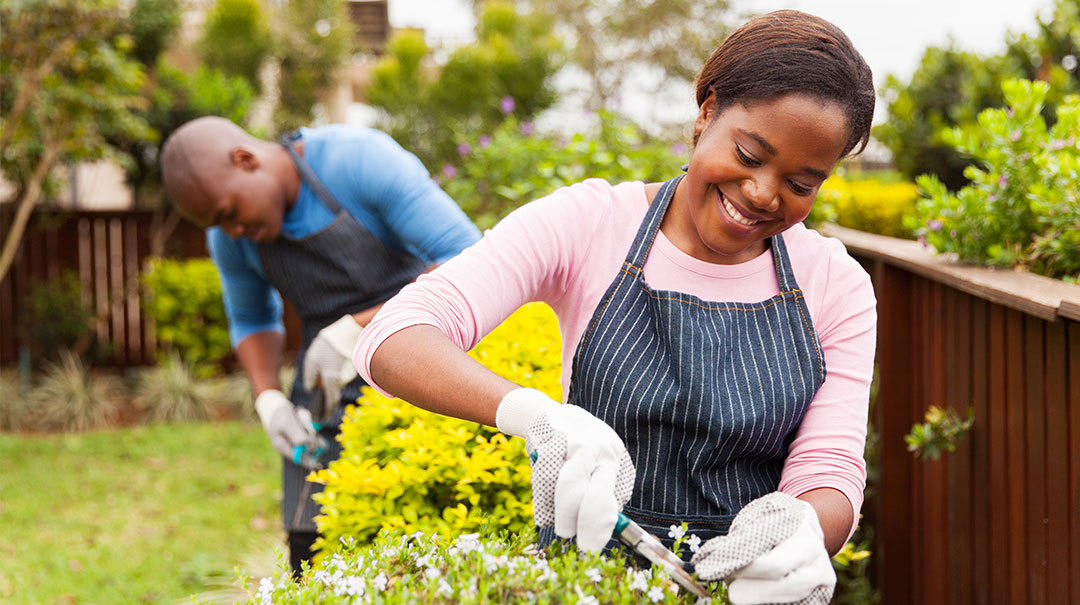For many of us, the time we spend gardening is enjoyable and even therapeutic. It’s important to remember, in addition to our fresh annuals and budding perennials, potentially dangerous hazards may also exist in our flower beds. From insects and bacteria to improper sitting and lifting, our yard work could lead to an injury or infection.
The most common gardening injuries include cuts and scrapes. Other gardening injuries can occur from lawn mower and tool accidents, ring avulsions, and using improper body mechanics, especially when lifting heavy loads.
How Cuts and Scrapes Can Lead to Infection
It’s easy to get small cuts and scrapes on exposed skin while working in the garden. The soil contains bacteria and fungi that are beneficial for plants, but can be harmful for us, and those cuts and scrapes are a gateway for bacteria to enter our bodies. There are two serious infections that can be contracted while gardening:
- Tetanus-an infection that can occur when contaminants found on garden tools or rose thorns enter the body, usually through cuts and scrapes. Symptoms may include weakness, stiffness, cramps, and muscle paralysis, particularly in the jaw. Muscle paralysis in the jaw, also known as lockjaw, can lead to difficulty chewing and swallowing.
- Sepsis-an infection introduced to the body through cuts and scrapes, particularly when handling soil, mulch, or fertilizer with animal manure. When sepsis enters the bloodstream, your body reacts with an inflammatory response. Sepsis can escalate quickly, leading to life-threatening septic shock and organ failure.
If you have a cut or scrape, the symptoms listed below could be a sign of infection. If you experience any of these, please seek medical attention right away.
- Redness near the irritation site
- Redness that expands beyond the cut or scrape
- Skin that’s warm to the touch
- Swollen lymph nodes
It’s important to remember, cuts and scrapes can happen anywhere on our body, not just our hands and fingertips. Be sure to wear gloves, long sleeves, long pants, and protective footwear.
What is Ring Avulsion?
Ring avulsion occurs when rings are caught on objects and your body’s weight follows, pulling or tearing the skin around the finger. Avulsions are not very common, but they are very serious injuries. Damage from the harsh tug can range from simple bruising, to degloving, and even finger amputation.
Degloving is when the finger’s skin is stripped from the bone, damaging the nerves and tendons. It can result in severe tissue loss, and in the most extreme cases, the amputated finger cannot be replanted. Side effects of ring avulsion include pain, bleeding, loss of sensation in the finger, discoloration, and disfigurement.
Preventing a ring avulsion is very simple: remove rings when gardening, operating machinery, and participating in sports or outdoor activities. Wearing gloves will not prevent an avulsion; the ring can still catch objects from under the glove.
How to Avoid Lawn Mower and Tool Accidents
Every year, we see partial or complete amputations from lawn mower accidents. It’s important to properly maintain and clean lawn mowers. Remember to always use a tool or broom, never your hands, to clean debris or dislodge jams from a lawn mower. Be sure to turn off the lawn mower and wait until the blade stops moving before clearing debris.
Even when the lawn mower is off, use a tool to clear jams. Sometimes, once the jam is removed, the blade will begin spinning again from momentum–even if the lawn mower is off!
Always wear proper clothing and protective gear, including footwear, when operating machinery, such as lawn mowers, edgers, and hedge trimmers. Wear sneakers, not sandals or bare feet, long pants, and safety goggles.
8 Tips to Prevent Gardening Injuries
Other gardening injuries include poison ivy and insect and spider bites. Though some of these injuries can be serious, the good news is most are easily preventable with proper clothing.
Here are eight simple tips for preventing gardening injuries:
- Wear gloves at all times. This will protect your hands and fingers from cuts and scrapes and potentially harmful bacteria.
- Wear protective clothing. Always wear long sleeves, long pants, and sneakers to protect your arms, legs, and feet from insect and spider bites, as well as cuts and scrapes. Additionally, wearing hats and sunscreen can protect your skin from prolonged exposure to the sun.
- Remove rings. By taking off your rings, you eliminate the chance of ring avulsion.
- Don’t sit back on your knees. Sitting back on your knees stresses knee joints and requires you to use your hands and wrists to stabilize. It also requires your hands and wrists to bear your weight while shifting from kneeling to standing. Try using a garden stool or bench.
- Use good body mechanics, especially when picking up heavy items like mulch or topsoil. You can prevent upper extremity and back injuries by distributing the weight, using your legs to lift, and keeping the load close to your body when lifting. Remember not to bend at the waist. You can also use a wage or wheelbarrow to transport heavy loads.
- Safely store your tools. Store sharp blades facing down and keep tools out of reach of children.
- Don’t drink alcohol. Avoid alcoholic beverages while gardening or mowing the lawn. Save the beer or cocktail for when your yard work is done.
- Take breaks. Stretch before, during, and after your yard work. Try to minimize sustained periods of repetitive motions, which can lead to tennis elbow and tendonitis.
Use these tips to stay healthy and injury free, while enjoying your time in the garden!
Want to learn more about how we can help you live a healthy life?
Click the button below to view the list of our services.
Learn More

